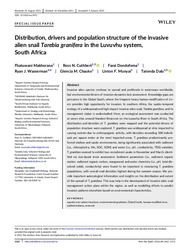Distribution, drivers and population structure of the invasive alien snail Tarebia granifera in the Luvuvhu system, South Africa
Makherana, Fhatuwani
Dondofema, Farai
Wasserman, Ryan J.
Chauke, Glencia M.
Munyai, Linton F.
DOI: https://doi.org/10.1002/rra.3937
Persistent URL: http://resolver.sub.uni-goettingen.de/purl?gldocs-11858/10390
Persistent URL: http://resolver.sub.uni-goettingen.de/purl?gldocs-11858/10390
Makherana, Fhatuwani; Cuthbert, Ross N.; Dondofema, Farai; Wasserman, Ryan J.; Chauke, Glencia M.; Munyai, Linton F.; Dalu, Tatenda, 2022: Distribution, drivers and population structure of the invasive alien snail Tarebia granifera in the Luvuvhu system, South Africa. In: River Research and Applications, Band 38, 8: 1362 - 1373, DOI: 10.1002/rra.3937.
 |
Dokument öffnen: |
Invasive alien species continue to spread and proliferate in waterways worldwide, but environmental drivers of invasion dynamics lack assessment. Knowledge gaps are pervasive in the Global South, where the frequent heavy human‐modification of rivers provides high opportunity for invasion. In southern Africa, the spatio‐temporal ecology of a widespread and high‐impact invasive alien snail, Tarebia granifera, and its management status is understudied. Here, an ecological assessment was conducted at seven sites around Nandoni Reservoir on the Luvuvhu River in South Africa. The distribution and densities of T. granifera were mapped and the potential drivers of population structure were explored. T. granifera was widespread at sites impacted to varying extents due to anthropogenic activity, with densities exceeding 500 individuals per square meter at the most impacted areas. T. granifera predominantly preferred shallow and sandy environments, being significantly associated with sediment (i.e., chlorophyll‐a, Mn, SOC, SOM) and water (i.e., pH, conductivity, TDS) variables. T. granifera seemed to exhibit two recruitment peaks in November and March, identified via size‐based stock assessment. Sediment parameters (i.e., sediment organic matter, sediment organic carbon, manganese) and water chemistry (i.e., pH, total dissolved solids, conductivity) were found to be important in structuring T. granifera populations, with overall snail densities highest during the summer season. We provide important autecological information and insights on the distribution and extent of the spread of T. granifera. This may help in the development of invasive alien snail management action plans within the region, as well as modelling efforts to predict invasion patterns elsewhere based on environmental characteristics.
Statistik:
ZugriffsstatistikSammlung:
Schlagworte:
aquatic non‐native invasionsenvironmental gradients
Global South
human‐modified river
quilted melania
reservoir
This is an open access article under the terms of the Creative Commons Attribution License, which permits use, distribution and reproduction in any medium, provided the original work is properly cited.

